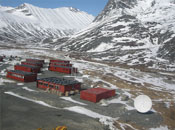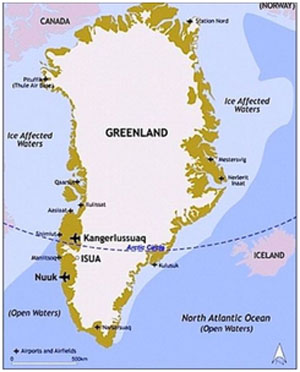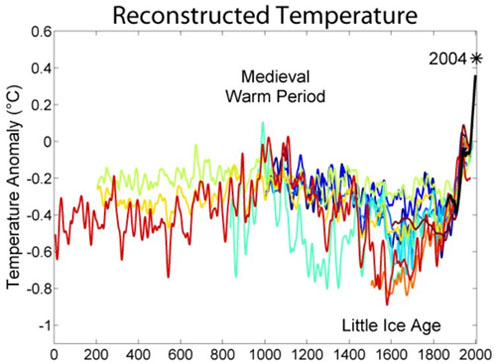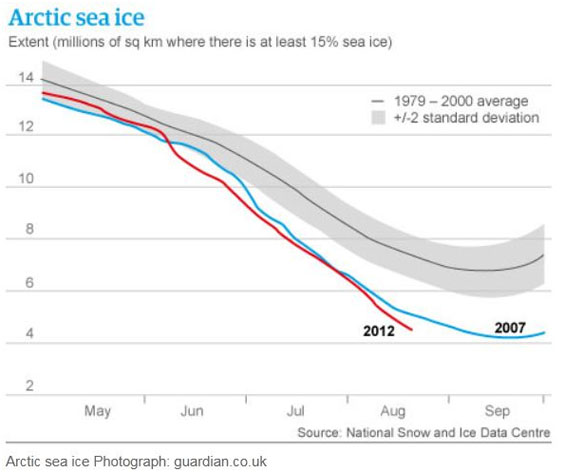

As a general rule, the most successful man in life is the man who has the best information.
Greenland is located in the North Atlantic Ocean adjacent to the Canadian Arctic archipelago. About 80% of Greenland is ice cap that can be up to 3 km thick. Approximately one-twentieth of the world's ice and one-quarter of the earth's surface ice is found in Greenland—the ice-free zone around the ice cap is up to 300 km wide and covers an area of 410,000 km² (area of Germany is 357,000 km).
Norsemen settled on the uninhabited southern part of Greenland in the 10th century.
"The descendants of the Vikings had persevered in their North Atlantic outpost for almost 500 years, from the end of the 10th century until the mid-15th century. The Medieval Warm Period had made it possible for settlers from Norway, Iceland and Denmark to live on hundreds of scattered farms along the protected fjords, where they built dozens of churches and even had bishops."—Günther Stockinger, Abandoned Colony in Greenland: Archaeologists Find Clues to Viking Mystery
Greenland has been inhabited, on and off, by Arctic peoples for up to 5,000 years. The Thule are the prehistoric ancestors of the current Greenlandic Inuit population. They left Alaska in about 1000 AD and arrived in Greenland, via dogsleds (usually made of driftwood with whalebone runners) and umiaks (large whaling and travelling boats constructed with a frame of walrus ribs covered with walrus hide), in the 13th century.

The Norse colonies had disappeared by 1500 AD, beaten by a cool climate turned much colder by the Little Ice Age—a period of cooling extending from about 1350 to roughly 1850.
According to radiocarbon dating of plant material it was almost the geological equivalent of turning off a light switch. Between 1275 and 1300 AD summers suddenly turned very cold, seas normally open froze over and glaciers started their inexorable advance. Between 1430 and 1455 AD the cold intensified substantially.
Contact was reestablished between Scandinavia and Greenland in the early 18th century and Denmark established rule over Greenland.
In 1979, Denmark granted home rule to Greenland. In 2008, Greenland voted to transfer more power from the Danish royal government to the local Greenlandic government. This became effective the following year. The 2009 Act on Greenland Self-Government gave Greenlanders authority over a number of new sectors including mineral resource activities.
Copenhagen remains constitutionally responsible for Greenland's foreign, defense and security policy.
As previously mentioned approximately 80 percent of Greenland is covered by ice with the exposed area forming a fringe around the coast. These non ice covered coastal areas - geological terrain that is simply an extension of the Canadian Shield - expose numerous mineral belts that are highly prospective for gold, lead, zinc, uranium, molybdenum, copper, tantalum and niobium, iron ore, nickel, several forms of industrial minerals, platinum group elements (PGE), diamonds, cobalt, rubies and rare earth elements (REEs).
As competition from the developing world pushes up the price of energy and minerals finding new sources of supply is crucial.

The combination of a stable political and regulatory landscape, global warming thawing Arctic sea lanes and large mineral reserves have made 'Kalaallit Nunaat - Country of the Greenlanders' an increasingly attractive location to look for minerals.
The population of Greenland is 56,648 with 14,719 inhabitants living in the capital Nuuk (formerly Godthab). The majority of Greenland's population live in towns along the fjords in the southwest of the country where the climate is relatively mild.
There are no roads between the towns on the coast so people travel by airplanes, helicopters or by boat.
Greenland is far from financially self-sufficient—currently there is just the revenue from fishing and a little tourism, there is no manufacturing sector.
Half of the Self-Rule administration's revenue is derived from the annual 3.5 billion kroner grant from Denmark.
A shortage of labor and the lack of infrastructure are the most formidable challenges facing the country. Both are huge stumbling blocks in the countries quest for self-sufficiency and financial independence by utilizing its natural resources.
The benefits from the country's emerging mining industry will include:
- Employment and job training for some of the highest paying jobs in the country. Providing jobs in 'rural' areas of the country with involvement of local laborers and local companies
- Education
- Infrastructure improvements in communities/cities. Also improvements in remote areas that remain long after each particular mine has shut down
- Financial independence from Denmark, significant tax revenues or royalties for government
- Business and investment opportunities
Mines need their own power plants and transportation facilities such as runways. Other projects, such as the planned construction of an aluminum smelter (Alcoa Inc. plans to launch a US$2 billion aluminum-smelting project in Greenland with an annual capacity of 360,000 tons as well as two hydroelectric power plants) would require first building basic infrastructure—roads, power plants and port facilities. It is estimated that the aluminum smelter alone would require over 5,000, mostly imported, workers to build.
Greenland, with a population of just over 56,000 and a workforce of only 36,000, is unable to provide the necessary labor to tackle their infrastructure issues on anything but a much smaller scale.
That is why the Greenlandic Parliament passed an act allowing large-scale extraction projects to use imported labor and contractors during the development phase of the projects. When the development phase is over the migrant workers must leave the country and the indigenous workforce will replace them.
Greenland's Bureau of Minerals and Petroleum (BMP) has so far awarded 150 licenses for mineral exploration with around 600 million kroner spent by companies in 2012—just 10 years ago there were almost no requests for mining licenses. Figures from the BMP show that the area covered by mining licenses increased over the last ten years from approximately 6,000 km2 to well over 40,000 km2.
A list can be downloaded here showing all active licenses and current applications.
Plans are on the table for a 12 billion kroner iron ore mine. London Mining (London Mining is a United Kingdom [UK] company, but most of the finance and direction comes from China) is going to use Chinese workers to build the mine, as well as to build power plants, new roads and a port near Nuuk—construction could start at the Isua iron ore deposit in 2013 and Greenland stands to earn a billion kroner in tax revenue.
China is presently leading the race to develop Greenland's resources with several Chinese companies trying to establish a presence in the country.
Chinese investors are reportedly preparing to put 1.3 billion kroner into major infrastructure projects, including three new airports and the expansion of port facilities in Nuuk—Chinese labor will be used in these projects.
But Greenland has strong historical ties to the European Union (EU) through Denmark and the Chinese will face stiff competition from not only the EU and Denmark, but from South Korea as well.
EU Industry Commissioner Antonio Tajani was in Nuuk last summer (2012) to sign a letter of intent (LOI) to cooperate with Greenland on its raw materials. South Korean President Lee Myung-bak signed several memorandums of understanding (MOU) with Nuuk in 2012, paving the way for Korea-backed science, exploration and resource development efforts in Greenland.
Currently Canadian and Australian listed company's dominate the mining exploration sector.
Proponents of Chinese investment say it will leave behind the infrastructure the country needs to develop but can't build on its own. Detractors would say that while Chinese investments were first welcomed by African states (there are roughly one million Chinese nationals working in Africa) poor construction, questionable business practices and a reluctance to use local workers brought a swift end to China's African honeymoon.
"Once the projects get started, they will influence many aspects of life in Greenland along the way." —Kuupik Kleist, Greenland's highest elected official
Conclusion
Dutch disease, in economics, means that an increase in revenues from natural resources will make a nation's currency stronger compared to that of other nations. The stronger currency has the effect of making exports more expensive for other countries to buy, thus making the manufacturing sector less competitive.
Greenlanders are soon going to reap the possible benefits—economic self-sufficiency and full independence from Denmark—of an international push to exploit its abundant natural resources.
The Danish Centre for Environment and Energy (DCE) has helped government officials in Nuuk carefully lay out stringent environmental guidelines. Mining activities, in regards to environmental, health and safety protection are also regulated by the Mining Act passed in 2009.
The rewards sure to come from investing in a few quality junior resource companies working in Greenland should be on all our radar screens. Is investing in Greenland on your screen?
If not, maybe it should be.
Richard Mills
Resource Investor



























































